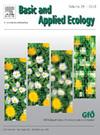德国自然2000网站的大多数栖息地和物种评估反映了不利的保护状态
IF 3.5
2区 环境科学与生态学
Q2 ECOLOGY
引用次数: 0
摘要
《生物多样性公约》旨在保护地球30%的陆地和海洋表面,以促进生物多样性。在欧洲联盟,自然保护区主要受到生境指令的保护。这些所谓的Natura 2000遗址目前覆盖了欧洲陆地面积的18.6%。强制性状态报告可以对保护状态进行广泛的分析,以调查生物多样性是否处于指令要求的有利保护状态,以及哪些因素可能受到抑制。以德国为例,我们评估了以标准数据形式评估的栖息地类型和物种群的保护状况,并将其与通常报告的站点驱动因素联系起来,例如土地利用实践、保护区规模和指定以来的时间。我们的结果是基于对德国23%(1049个)受栖息地指令保护的自然2000点的评估,结果表明只有6%的栖息地和4%的物种评估报告了良好的保护状况。对报告的驱动因素的审查表明,对Natura 2000站点的大多数负面影响归因于农业和林业活动以及自然系统的改变,而对于这两种土地利用类型也列出了具有积极影响的做法。在栖息地方面,在Natura 2000中,建立时间越早的保护区保护状况越好。对于栖息地和物种来说,总体而言,更有利的保护状态与更大的面积和缺乏直接土地利用(农业、林业)有关。我们的研究结果强调,当土地利用活动继续影响目标物种或其栖息地时,仅靠高比例的保护区不足以推断生物多样性保护的成功。为了实现最近实施的《欧盟自然恢复法》的目标,需要加强对“自然2000”地区的对话努力。本文章由计算机程序翻译,如有差异,请以英文原文为准。
Most habitat's and species' assessments in German Natura 2000 sites reflect unfavourable conservation states
The Convention on Biological Diversity aims to protect 30 % of the Earth’s land and marine surface to promote biodiversity. In the European Union, conservation areas are mainly placed under protection through the Habitats Directive. These so-called Natura 2000 sites currently cover 18.6 % of Europe's land area. Obligatory status reports enable a broad-scale analysis of conservation states to investigate if biodiversity is in the favourable conservation status demanded by the directive and which factors may be inhibiting. With focus on Germany, we evaluated the conservation states of habitat types and species groups as assessed in standard data forms and related it to drivers commonly reported for the sites, e.g., land-use practices, protected area size and time since designation. Our results are based on assessments from 23 % (1049) of Germany’s Natura 2000 sites protected under the Habitats Directive and show that only 6 % of habitats’ and 4 % of species’ assessments report a favourable conservation status. A review of the reported drivers showed that most negative influences on Natura 2000 sites were attributed to agricultural and forestry activities, as well as natural system modifications, while for both land-use types also practices with positive impact were listed. For habitats, conservation status was better in Natura 2000 sites that were established earlier than later. For both habitats and species, more favourable conservation states were overall related to larger area sizes and the absence of direct land use (agriculture, forestry). Our results highlight that a high proportion of protected areas alone does not suffice to infer successes for biodiversity conservation when land-use activities continue to affect target species or their habitats. Increased conversation efforts for Natura 2000 areas will be required to meet the goals of the recently implemented EU Nature Restoration Law.
求助全文
通过发布文献求助,成功后即可免费获取论文全文。
去求助
来源期刊

Basic and Applied Ecology
环境科学-生态学
CiteScore
6.90
自引率
5.30%
发文量
103
审稿时长
10.6 weeks
期刊介绍:
Basic and Applied Ecology provides a forum in which significant advances and ideas can be rapidly communicated to a wide audience. Basic and Applied Ecology publishes original contributions, perspectives and reviews from all areas of basic and applied ecology. Ecologists from all countries are invited to publish ecological research of international interest in its pages. There is no bias with regard to taxon or geographical area.
 求助内容:
求助内容: 应助结果提醒方式:
应助结果提醒方式:


